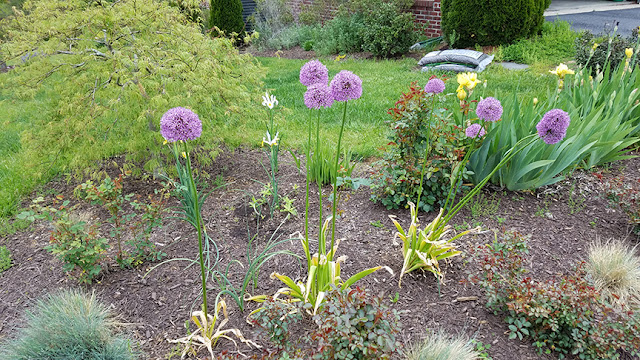I really miss the Virginia native Plant Society (VNPS) hikes this spring, so on 4/29 I decided to do a spring walk in the woods in back of my house, to see how many plants I could identify on my own. I usually don't go in there after the trees leaf out because I fear the poison ivy and noxious insects, but at this time of the year it's fairly safe.
There are several dogwoods in bloom that can be seen from my back yard. The big trees are mostly black and northern red oaks in their dotage, with some hickories (Bitternut and Pignut). The fact that there is a quite a diversity of plant species leads me to believe that my patch of woods is a small strip of native vegetation that was left undisturbed when the neighborhood was built, probably because the slope down to the drainage ditch is so steep.
Over the years I've managed to identify some of the understory trees. The distinctive flowers of the Witch Hazel trees (
Hamamelis virginiana) are visible in the fall and winter months; there is a large patch of them on the east corner of my lot extending into my neighbor's.
 |
| Witch hazel |
Another understory tree on the opposite (western) side of my lot is the American Hop-hornbeam (
Ostrya virginiana). About three summers ago I noticed a particularly abundant crop of the characteristic hop-like fruit on several trees in back, which allowed me to identify them. My explorations this spring reveal that these are growing all over.
 |
| Hop-hornbeam |
 |
| Pignut |
There are several hickories too--Pignut hickory (
Carya glabra) and Bitternut hickory (
Carya cordiformis)--the nuts fall into my yard and the squirrels bring them too. There's also the ubiquitous red maples, perhaps silver and other maples I have yet to identify, bird cherries (Prunus avium), a few dogwoods, and possibly a Serviceberry that bloomed sparsely earlier on.
Further down toward the forest floor are a bunch of what I believe are Late Low Blueberries
(Vaccinium vacillans)--much browsed by deer--and some shoots of bedstraw.
 |
| Blueberries |
Going down the steep slope towards the drainage ditch I found a few Lady ferns, (
Athyrium filix-femina) and patches of Winterberry (
Gaultheria procumbens) and star chickweed (
Stellaria pubera) on the forest floor. There were also goldenrod shoots, blackberries, and the usual annoying honeysuckle vines.
 |
| Chickweed with Wintergreen |
At first I wasn't sure what the plants below were, but farther down I found one plant with flowers and was able to identify it as Solomon's seal (
Polygonatum biflorum). I'd seen two lovely specimens of this plant farther up the slope a couple of days earlier, but when I started to look for those, they'd vanished. Eventually I located two decapitated stems--the deer had eaten them!
 |
| Solomon's seal |
The day was so warm and lovely that I continued downhill crossing my neighbor's woods towards the creek that flows from a neighboring farm. There is a small clearing here where more sunlight reaches that can host moisture-loving species typical of our area: Golden Alexanders (
Zizia aptera), Spring Beauty (
Claytonia virginica), and Bluets (
Houstonia caerulea).
 |
| Golden Alexanders |
 |
| Spring Beauty |
 |
| Bluets |
|
|
Walking along the spongy creek bed I noticed a distant clump of shrubs and small trees with bunches of white flowers. These looked so familiar, I got closer to confirm my suspicions, and they were native Black Haw Viburnums (
Viburnum prunifolium), exactly like the two planted in my yard.
 |
| Viburnums |
Doubling back towards the drainage ditch, I found a plant of Golden Ragwort (
Packera aurea), a clump of Mayapples
(Podophyllum peltatum), a Buttercup and more Rattlesnake Weed
(Hieracium venosum).
 |
| Golden Ragwort |
 |
| May-apples |
 |
| Rattlesnake Weed |
In my own back yard again, I continued through my woods toward the other end of my property, coming across lots of patches of Squawroot (
Conopholis americana). This plant lives as a parasite on oak tree roots, and has no leaves.
 |
| Squawroot |
I also came across a small woody plant with unfurling leaves that I thought might possibly be a native azalea, although the leaves seem a bit large for such. I'll try to keep track of this one as it grows to see if I can identify it.
 |
| Unidentified |
I continued walking through the woods under the Hop-hornbeams before emerging onto
the grassy hillside on my other neighbor's property for the conclusion
of a fruitful afternoon exploring my woods.














































